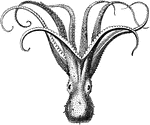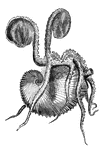Clipart tagged: ‘squid’
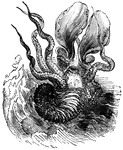
Greater Argonaut
The greater argonaut (Argonauta argo) is a cephalopod and a species of pelagic octopus also known as…

Cephalopoda
"Cephalopoda is a class of mollusks, the highest in organization of the division of the animal kingdom.…
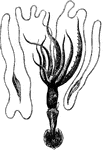
Bonelli's Cheiroteuthis
"Has the body eight inches long, and the longest tentacles nearly three feet." — Goodrich, 1859
!["In one genera [of the <em>Octopodidae</em> family] the arms are completely united in their whole extent by a thin membrane."](https://etc.usf.edu/clipart/51600/51665/51665_cirrh_muller_mth.gif)
Cirrhoteuthis Mulleri (Eschricht)
"In one genera [of the Octopodidae family] the arms are completely united in their whole extent…
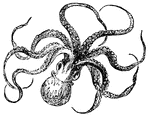
Cuttlefish
The body of the cuttlefish is soft and covered only with a leathery skin. Its eight arms are very long.

Cuttlefish
Cephalopods are the most highly organized Molluscs. The head is distinct, carrying two large globular…

Common Cuttlefish
The Common Cuttlefish (Sepia officinalis) is a mollusc in the Sepiidae family of cephalopods.

Giant Squid
"Giant Squid (Architeuthis dux). (From Report of U.S. Fish Commission, 1884.)-Whitney, 1902

Loligo Gahi (d'Orbigny)
"The Common Calmar or Squid. They propel themselves backward through the water with great velocity,…

Loligo Vulgaris, with its pen, or internal bone (Lamarck)
"The Common Calmar or Squid. They propel themselves backward through the water with great velocity,…
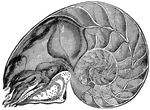
Nautilus
Chambered nautilus, showing chambers with soft body in outer chamber. It is closely related to the squids…

Octopus
Octopus, a mollusk related to the squid. It has eight arms with suckers, arranged around a central soft,…
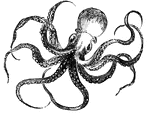
Octopus
Octopus, a mollusk related to the squid. It has eight arms with suckers, arranged around a central soft,…

Octopus
As the name indicates, the octopus has eight arms instead of ten, as in the squids and cuttles.
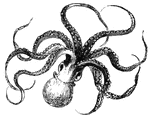
Octopus
Part of the cephalopod group. The name cephalopod is derived from two greek words which mean feet on…

Octopus Brevipes (d'Orbigny)
"A very ugly-looking creature, which belongs to the Octopodidae family, is the Octopus."

Octopus Horridus (d'Orbigny)
"A very ugly-looking creature, which belongs to the Octopodidae family, is the Octopus."

Octopus Macropus (Risso)
"A very ugly-looking creature, which belongs to the Octopodidae family, is the Octopus."

Octopus Vulgaris (Lamarck)
"A very ugly-looking creature, which belongs to the Octopodidae family, is the Octopus."
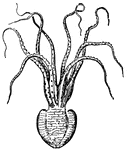
Pinnoctopus Cordiiformis (Q. & G.)
This creature, belonging to the Octopodidae family, "changes its color under any exertion,…
!["Cuttlefish are probably the most interesting animals of [the cephalopoda] order. They live for five or six years, and lay eggs, which are large and generally found in clusters, and are known to fishermen as sea-grapes."](https://etc.usf.edu/clipart/51600/51626/51626_sepia_offici_mth.gif)
Sepia Officinalis (Linnaeus)
"Cuttlefish are probably the most interesting animals of [the cephalopoda] order. They live for five…

Squid
The squid is the best example of the cephalopod group. It is abundant along the Atlantic coast. Squids…

Hooked squid
"Its length from tail to the end of the tentacles is six feet. The two largest of these are furnished…
